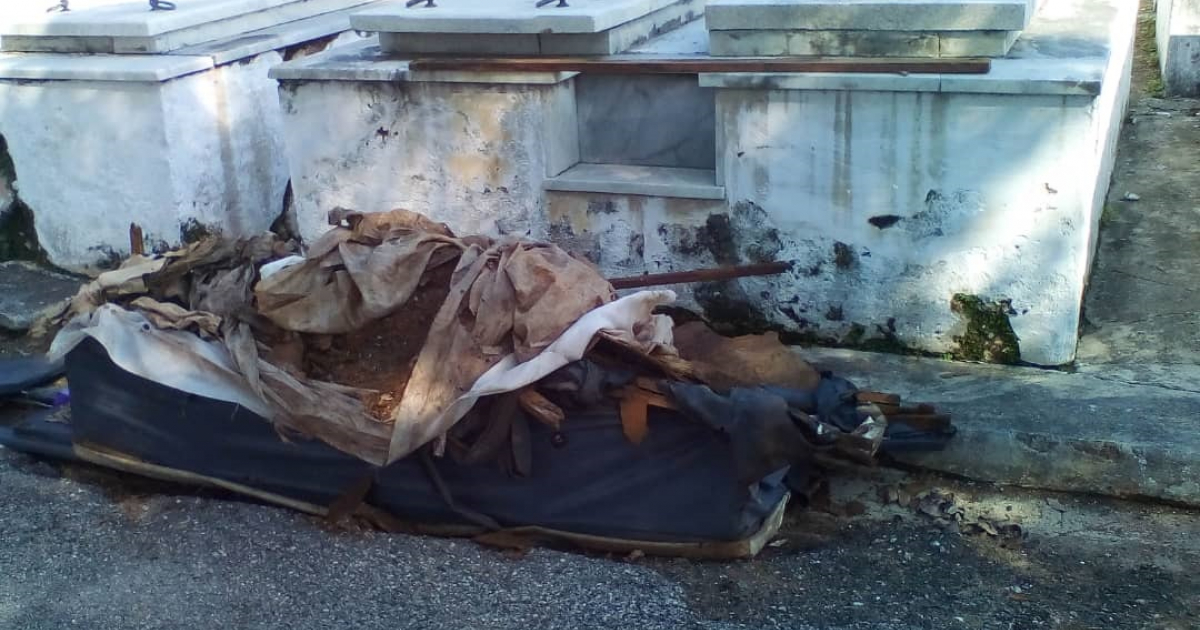
The economic crisis causes general deterioration, a shortage of flowers, thefts, looting and bad smells in the Christopher Columbus cemetery in Havana, they toldCyberCuba relatives of the deceased and employees of the main necropolis of the island, declared a National Monument in 1987.
Remains of recent exhumations in the streets, scarcity of flowers that also reaches the mythical tomb ofThe miraculous, broken and deteriorated tombs and pantheons and smells of decomposing corpses is the current panorama of the largest cemetery in Cuba.
"Many people don't know it, but sometimes we have to remove the glass from the box that covers the face and part of the chest of the corpses because the country cannot import that special glass," said a Community Services worker.
Last spring,Cuban crematorium workers asked President Díaz-Canel to eliminate occupational risks due to coronavirus.
"Everything got complicated overnight and it was very sad," María Luis Páez, a Community Services worker in Pinar del Río, recently told the state newspaper.Granma.
In normal times, in the main municipality of Pinar del Río in Pinar del Río, between three and six burials are carried out on average in a day, but the numbers skyrocketed during the coronavirus, the official explained, without specifying data on deaths from coronavirus, in the most western part of Cuban cities.
"It was a very strong experience in every sense (...) in circumstances like this, there has to be a lot of cohesion, a lot of unity and a lot of commitment from the workers to face an unprecedented situation in Vueltabajo," he said.
The deterioration of the Colón cemetery began in the economic crisis of the 1990s, including the looting and sale of marbles and other valuable elements; but it also reaches the other 20 cemeteries in Havana, where deficiencies and neglect multiply, aggravated by the deaths caused by the coronavirus pandemic, as happened in the rest of the country.
The miraculous
The famous tomb ofThe miraculous, to whom popular belief attributes magical healings, achieving complicated pregnancies, trips abroad, romantic reconciliations, economic improvements and other prodigies, looks this week with much less than half of the flowers that anonymous hands keep as permanent offerings to its powers.
The Miraculous, which remains the most visited tomb in the cemetery, houses the remains ofAmelia Goiry de la Hoz, a middle class lady at the beginning of the 20th century, who fell in love with her cousinJosé Eduardo Adot Rabell, but the poverty of the boy; It provoked opposition from Amelia's parents, who had to wait for her father's death to be able to marry the man she loved.
Amelia and her first and only daughter, died from complications of childbirth, derived from the eclampsia (very severe hypertension) of the pregnant woman, on May 3, 1901, Day of the Holy Cross for Catholics, being buried in a modest vault in the cemetery. of Columbus, because her husband opposed her being buried in a luxurious pantheon.
The girl was buried at her mother's feet, as established by the norms of the time, and their deaths emotionally upset the widower, who began to visit their grave two or three times a day, hitting the tombstone with one of the rings. to wake up Amelia, maintaining this habit until his death, which occurred 40 years later, according to chronicles in the Cuban republican press.
The sad story reached the ears of the famous Cuban sculptor José Vilalta Saavedra, who offered to create a sculpture of the woman with her daughter in her arms, even though he was on a work trip in Italy; where he carried out the work and personally took it to Havana in 1909.
With 57 hectares of extension, Colón is the most important cemetery in Cuba, it was built in 1876 and contains a large number of sculptural and architectural works, several looted or damaged, merits that placed it as a world-renowned necropolis, being the only one, of the region, dedicated to the discoverer of America.
The main entrance of the cemetery, on Zapata Street in Vedado, is topped by a sculptural set of Carrara marble, the work of Vilalta Saavedra, which symbolizes the three theological virtues: Faith, Hope and Charity; a mural representative of the shortcomings and desires of the impoverished and unequal Cubans of 2022.
What do you think?
SEE COMMENTS (1)Filed in: